Berlin History In 2001, I arrived in Berlin (pronounced Bear-LEEN) by train at night and the drive from the Zoo Station to my hotel near the Brandenburg gate was a magnificent sight. The beautiful modern buildings were lit up and I noticed that the names atop the buildings are mostly those of German corporations, not like the rebuilt city of Warsaw where most of the businesses are American. The city of Berlin is built on a plain, so it is as flat as a pancake except for a mound where the pile of cleared rubble was covered over with grass. Berlin used to be five separate towns, so it is spread out like Los Angeles, not a skyscraper canyon city like San Francisco or New York. The city covers a vast area which is 40% open space with many parks and stretches of water, including the river Spree, which seems to have remarkably clean water. The river connects the three main lakes: the Wannsee, the Tegeler See and the Müggelsee. The city covers a total area of 340 square miles; it is 28 miles wide from east to west, and 24 miles long from north to south. However, it is easy to get around, once you learn the rail system which is laid out in an orderly fashion. I was able to go from the center of the city to the suburb of Oranienburg and then all the way to Wannsee, another suburb on the opposite side, on the S-Bahn, which is what Californians would call rapid transit or the light rail. When I first arrived, my taxi ride from the airport to my hotel took me down the Strasse des 17 Juni (June 17th Street). Formerly called Charlottenburger Chausee, it was renamed to commemorate an uprising by East German workers in 1953. This broad avenue which leads to the famous Brandenburg Gate, separating East Berlin from West Berlin, cuts through the Tiergarten park and is lined on both sides with lime trees which look as though they were planted after the end of the war. At the Brandenburg Gate (Brandenburger Tor), the street becomes Unter den Linden on the East Germany side. The next day when I drove through both sides of the former divided city, I noticed that West Berlin has lots of trees and large flower pots decorating the streets, while the ground in East Berlin is mostly solid concrete. On the north side of Strasse des 17 Juni is the Soviet War Memorial, erected in honor of the Red Army troops who died in the Battle of Berlin. It was built from the marble of the destroyed Reich Chancellery building, which was Hitler's headquarters, and is flanked by the two Russian tanks that were the first to enter Berlin.  In the middle of this broad avenue, on the West Germany side, is one of Berlin's most famous landmarks, the Siegessäule, the victory column which is a monument to the military victories of Prussia. The column was originally located on what is now called the Platz der Republik, but it was moved in 1938 on Hitler's orders to this spot. It is 70 meters high and topped by a gold-plated statue which symbolically faces France to the west. It was the Prussian victory over France in the Franco-Prussian War of 1870 that led to the unification of the German states in 1871. 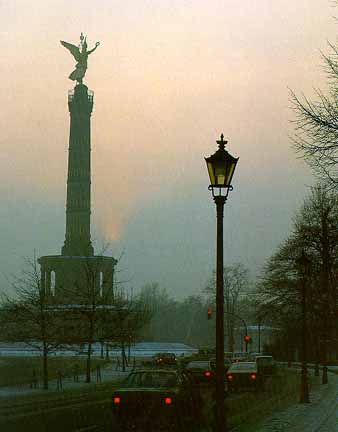 In 1999, Berlin once again became the capital of a united Germany, and the government moved to the newly renovated Reichstag building after being located in Bonn since the fall of the Third Reich. 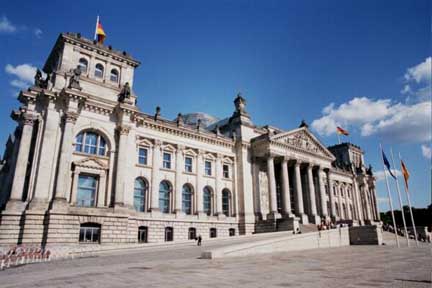 Berlin was originally the capital of the kingdom of Prussia and then became the capital of a united imperial Germany when the Second Reich was proclaimed in the Hall of Mirrors at Versailles on January 18, 1871 following Prussia's victory over France. Bitterness over this war was the reason that the peace treaty which ended World War I was also signed at Versailles and part of the reason that the French declared war on Germany in September 1939 to start World War II after the Nazis had violated the treaty by invading Poland only twenty years later. 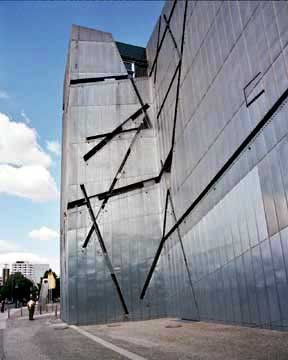 When Hitler became Chancellor in 1933, there were 585,000 Jews living in Germany; the largest Jewish community was in Berlin with 160,000 Jews. Only 7,000 returned to Berlin after the war. The Jews had been expelled from Berlin in 1573 and not allowed back in the city for 100 years. In Berlin, the Jews were never forced to live in a ghetto, but the Eastern European Orthodox Jews lived in the Jewish quarter called the Scheunenviertel, northwest of the Alexanderplatz. When the German states were united by Bismarck in 1871, the German Jews were granted full rights of citizenship, which was unusual for that time when the Russian Jews were still being forced to live on a reservation called the Pale of Settlement. The only other European country with a large population of Jews, which had granted them full rights, was Austria. 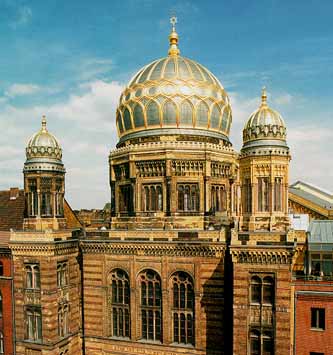  Bismarck was a friend of the Jews and in 1866, he was present when Berlin's grand Neue Synagogue was opened at Number 30 Oranienburger Strasse. The Synagogue was burned during Kristallnacht on November 9, 1938 but the blaze was put out before much damage was done. The Nazis occupied the building in 1940 and desecrated the Synagogue by using it for storage. The Nazis also destroyed the Jewish cemetery in Berlin. The Synagogue sustained severe damage by Allied bombs during the war and for years it was left as an empty shell. Restoration began in 1988 and the Synagogue was reopened on May 7, 1995, the 50ieth anniversary of the German surrender. Like many of the Synagogues in Poland, and even in America, it is guarded around the clock. Berlin was the residence of Karl Marx, the son and grandson of Jewish rabbis, the man who introduced Communism to the world when he published his Communist Manifesto in 1848. This prompted a revolution in Germany, which failed, and resulted in the emigration of a number of German liberals to America where they became known as the "Forty-Eighters." Berlin also became the center of the social democratic movement, the worker's movement and the trade union movement in Germany. It was the headquarters of the Social Democratic Workers Party, founded by Karl Liebknecht and August Bebel. During World War I, a new militant leftist group formed by Jewish leaders, Karl Liebknecht and Rosa Luxemburg, agitated for the overthrow of the Kaiser and the end of the war. The war effort was hampered when 300,000 workers went on strike in January 1918. In November 1918 there was a naval mutiny and a strike of the dock workers. Finally, on November 9, 1918, Philipp Scheidemann, the Jewish leader of the Social Democrats, proclaimed the first German Republic from a window of the Reichstag building in Berlin. Twenty years later, the Nazis, who always blamed the Jews for Germany's defeat in World War I, carrid out the pogrom which became known as Kristallnacht on November 9, 1938. Thirty thousand Jewish men, many of them from Berlin, were rounded up and sent to the concentration camps at Dachau, Sachsenhausen and Buchenwald. They were held for at least two weeks and then released if they promised to leave Germany within six months. The Kaiser was forced to abdicate in November 1918 and the government was taken over by the SPD (Social Democrats). The Jewish leader Friedrich Ebert was subsequently installed as the first president of the new Republic. The Armistice which ended World War I was signed by Matthias Erzberger, a representative of the Ebert government, on November 11, 1918, an event which is now celebrated in America by the Veteran's Day holiday. The Nazis would later call the Social Democrats "the November criminals" and characterize the signing of the Armistice as a "stab in the back" for the German people. For the next 20 years, a controversy would rage between the liberal left and the right wing Nazis over whether or not the German army had been defeated on the battlefield, a claim which Hitler called the "Big Lie." After the Armistice, Berlin was in total chaos; the city resembled a war zone with revolutionaries fighting in the streets. Before a new democratic constitution could be written, a militant group of leftists, called the Spartacus League, attempted to set up a soviet government, along the lines of the Communist revolution in Russia in October 1917. Their leader, Karl Liebknecht, proclaimed another Republic from the balcony of the imperial palace in Berlin. The Soviets tore down the palace, but preserved the section where the hero Liebknecht proclaimed the Communist Republic. The Spartacus League renamed itself the German Communist Party (KPD) and called for a general strike of the workers in January 1919. A volunteer group of 3,000 former soldiers, called the Freicorps, was called in to restore order. They fought against the Red Front (Communist) soldiers in hand to hand combat on the streets of Berlin. The leaders of the Communists, Liebknecht and Luxemburg, were dragged from their hiding place and murdered in the Tiergarten park in the center of the city; Luxemburg's body was thrown into the Landwehr Canal. A monument to Rosa Luxemburg now stands in the Tiergarten. Many of the Nazi leaders came from the soldiers, who fought with the Freicorps to put down the Communist Revolution, and the soldiers who fought in World War I, including Adolf Hitler who had been a lance corporal in the German Army. Their memories of the street fighting and the paralyzing workers' strikes was the source of their later persecution of the Communists, Social Democrats and trade unionists after they gained power in January 1933. At the beginning of August 1945, three months after the German surrender which ended World War II, American President Harry Truman was on his way to Potsdam, a suburb of Berlin, for a conference with Allied leaders Churchill and Stalin, when he took a victory lap around Berlin in an Army Jeep to see the devastation wrought by the Allied bombing. There was not much left of Berlin to see. The capital city of Germany had been bombed 24 times between November 18, 1943 and March 1944, and sporadic hits continued until the city was captured by the Russian army in April, 1945. By that time, the city had been reduced to 98 million cubic yards of rubble. 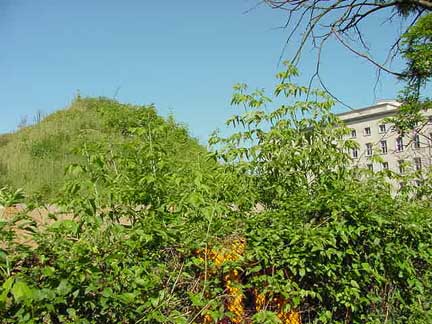 Each of the bomb attacks involved over 1,000 planes and the dropping of up to 2,000 tons of bombs. Half of the city's bridges were destroyed and the underground railway tunnels were flooded. There was no gas, electricity or water in the central portion of the city. The pre-war population of 4.3 million had been reduced to 2.8 million, as people were forced to flee the city; some 1.5 million people became homeless when their homes were bombed. One out of 7 of the buildings destroyed in Germany by the Allied bombing were in Berlin. Out of a total of 245,000 buildings in Berlin, 50,000 had been completely destroyed and 23,000 had been severely damaged; 80,000 residents of the city had been killed. Even the trees in the Tiergarten, a large park in the center of the city, had been killed in the Battle of Berlin. There were so many historic buildings destroyed that Berliners jokingly referred to the American and British air raids as Baedecker Bombing. Baedecker travel guide books were used by tourists to locate famous and historic buildings. A mere 5 years earlier, after the conquest of France in 6 weeks time, Hitler had visited Paris and taken an early morning tour of the deserted streets to see the famous buildings of the capital city, which were all still intact. Hitler's earliest ambition had been to be an architect, and he made sure that the beautiful buildings of Paris were not destroyed. Before World War II started, Hitler had big plans to completely rebuild Berlin into a world class city with classic buildings which he and his chief architect, Albert Speer, were working together to design. At least part of his dream has now been realized. The rubble has been cleared away and Berlin has been completely rebuilt with stunning new modern architecture, although Hitler would hardly approve of the new Berlin, since he hated anything modern, calling it "entartete Kunst" (degenerate art). 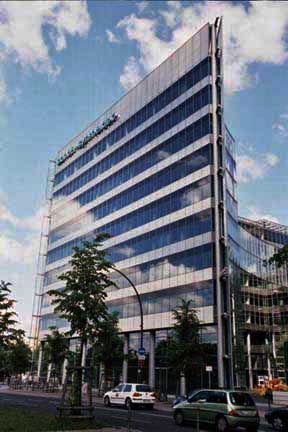 When I first visited Berlin in 2001, West Berlin looked a bit like Chicago, while the former East Berlin had a skyline dominated by huge yellow cranes which were being used to build dozens of new buildings. On November 9,1989 the Berlin Wall, which was built overnight in 1961 to divide postwar Berlin into two sectors, was torn down and the city was reunited. November 9th was the anniversary of the day in 1918 when the Social Democrats first proclaimed a republic, as well as the anniversary of Kristallnacht and the Putsch by Adolf Hitler in 1923. Since the wall came down in 1989, the former East Berlin has become westernized and now has a McDonald's on the main Berlin boulevard, Unter den Linden. 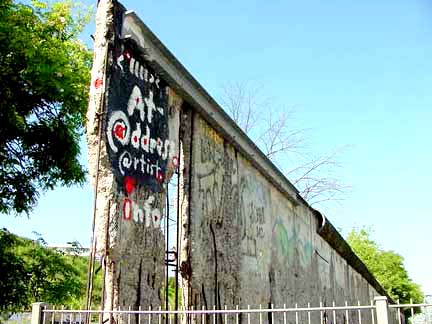 The area around the Brandenburg Gate is a tourist mecca with a place for tour buses to park on the West Germany side. From this side, the view of the gate, with its classic Greek architecture, is spoiled by a modern radio and television tower, called the Fernsehenturm , which was built in 1969 in East Germany. Berlin has no skyscrapers like New York City and the television tower seems to be the tallest structure in the city. The statue of a horse-drawn chariot, on the top of the Brandenburg Gate, faces the East Germany side, as shown in the picture below. The gate was built in 1791 as a triumphal arch; it was designed by architect Carl Gotthard Langhans, who modeled it on the Propylaea in Athens. The Brandenburg Gate has seen a lot of history. It is where Napoleon did his victory march in 1806, and where the revolutionaries met in 1848 when they attempted the overthrow of imperial Germany; it is where the Communists aimed their rifles from the statue on top during their attempted revolution of 1919, and where the Nazis held torch-light parades after they ended the democratic Weimar Republic which was the outcome of the November 1918 bloodless revolution of the Social Democrats. When you pass through the Brandenburg gate you are on the Unter den Linden (Under the Lime Trees) which is Berlin's grand old boulevard. The street has a center pedestrian strip which has two rows of lime trees. Most of the trees had to be replanted after they were destroyed in World War II. What little is left of the old Berlin is on this side which was formerly the East Germany sector of the city. From 1961 to 1989, the Unter den Linden was a dead end street, cut off from the other side by the concrete Berlin Wall which was built to keep East Berliners from escaping from Communism. The year before the wall was built, 200,000 East Berlin citizens had defected to the West. Many of the classic old buildings have been restored after being damaged by Allied bombs. One of the old buildings that I saw was Humboldt University, built in 1748. Communist founder Karl Marx was an alumni, as were such Communist heroes as Friedrich Engels and Karl Liebknecht. Marx was influenced by Hegel (rhymes with bagel) who was on the university faculty. Albert Einstein was also on the faculty of the university before he emigrated to America to escape the Nazi persecution of the Jews. Directly across from the university is Bebelplatz, named for August Bebel, the founder of the Social Democrats, the political party that proclaimed the German Republic from a window of the Reichstag on November 9, 1918 to end the imperial rule of the Hohenzollerns. "Red Berlin" has traditionally been a left-wing liberal stronghold. All around you in Berlin, you will see places named for Communists or Social Democrats, for example, Breitscheid Platz, named after the Chairman of the Social Democrat party who was killed by Allied bombs in Buchenwald, where he was a prisoner of the Nazis during the war. There is a bridge named after Karl Liebknecht and another plaza named Marx-Engels-Platz. Unter den Linden becomes Karl-Liebknecht Strasse after a certain point and leads to the Alexanderplatz. During the Nazi era, Bebelplatz was known as the Opernplatz because the German Opera House is on the east side of the square. This was the site of the huge bonfire on May 10, 1933 when books by Jews and liberal leftists were burned by the Nazis. There is now a memorial piece of art there, created by Jewish artist Micha Ullman. On the spot where the books were burned, there is an underground room with empty shelves, which can be seen through a glass panel. In the photo below, a student is looking through the glass into the room with empty shelves. 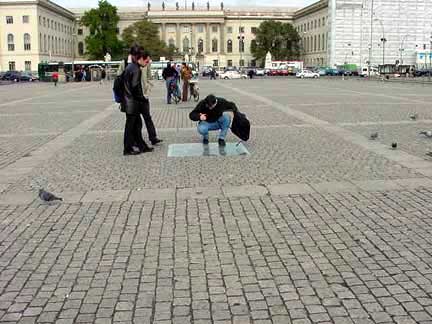 There are several impressive cathedrals in this area, including the Berliner Dom, pictured below. It is a huge structure with multiple domes. Built as a Protestant church during the reign of Kaiser Wilhelm II, it has reopened after 20 years of restoration work. It was damaged in an Allied bombing raid in 1944. 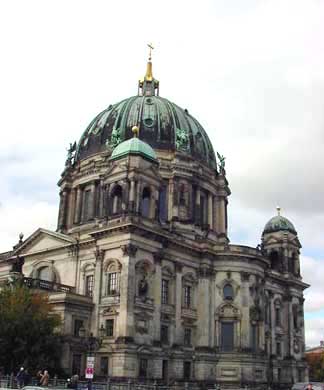  HomeThis page was last updated on October 8, 2008 |